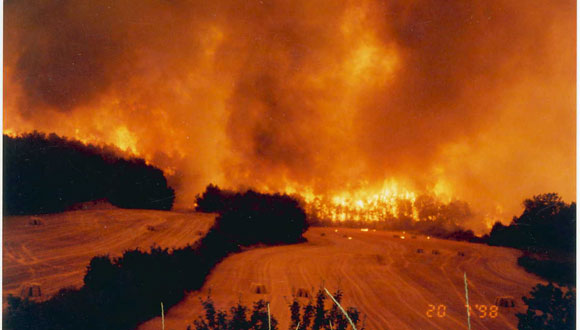Firefighters are the main factor that determines the current patterns of forest fires in Catalonia
A new model of landscape evolution, developed by a group of Catalan and Canadian researchers, identifies that the ability to extinguish fire is essential in the explanation of the fire patterns in Catalan territory. The model also shows that, if current climate trends continue, the burned area could increase by more than 60% in the next 20 years.

Forest fires play a fundamental role in many terrestrial ecosystems. Despite this fact, the truth is that the main factors that determine fires incidence in heavily human-impacted regions is still not understood well enough. This makes the impact of fire in these areas difficult to predict. Now, a group of Catalan and Canadian researchers have analyzed the results of a new model of landscape evolution that allows us to study this phenomenon from a new point of view. These results, published in the journal PLOS ONE, show that the current pattern of fire in Catalan territory depends on the efficiency of firefighters and their actions.
The model was able to predict the burned surface area in Catalonia between the years 1990 and 2000, but has not been able to recreate the burned surface area between 2000 and 2012, except in those cases where the model, unlike in the previous period, introduced an increase in firefighter efficiency by using fire extinction opportunities.
The fire extinction opportunities are in areas of the landscape with specific characteristics that allow firefighters to anticipate changes in fire behavior and stop its progression. Only in the case of the Girona fire did the model fit the observed data without the need to incorporate firefighter actions in any significant manner.
The results also indicate the historical impact of fires and how they contribute, for a while, to limiting the impact of new fires, offering more easily predictable opportunities for fire extinction. Finally, projections derived from the model showed that, if current climate trends continue, the burned surface area in the next 20 years could increase by more than 60%. However, the role of the strategies and decisions taken in fire control implementation are relevant factors critical to arriving at or reducing this predicted value.
According to Lluís Brotons, CTFC-CREAF researcher, "the results of this study provide a framework to guide decisions that will mark the future of our forest landscapes."
In addition, these results identified the importance of the fire extinction strategies on the impact of forest fires in Catalonia and reinforce the idea that in the Mediterranean, unlike what happens in other regions of the world, fire patterns are a changing concept according to the relative weight of environmental and social factors. Finally, Lluís Brotons emphasizes the idea that, even with highly efficienct extinguishing systems, fire activity will continue to be present in Mediterranean landscapes and, therefore, one cannot lower one’s guard in a future that will surely include an increase in large forest fire risk situations.
Text adaptation of: http://biodiversitylandscapeecologylab.blogspot.com.es/2013/05/how-fire-history-fire-suppression.html







